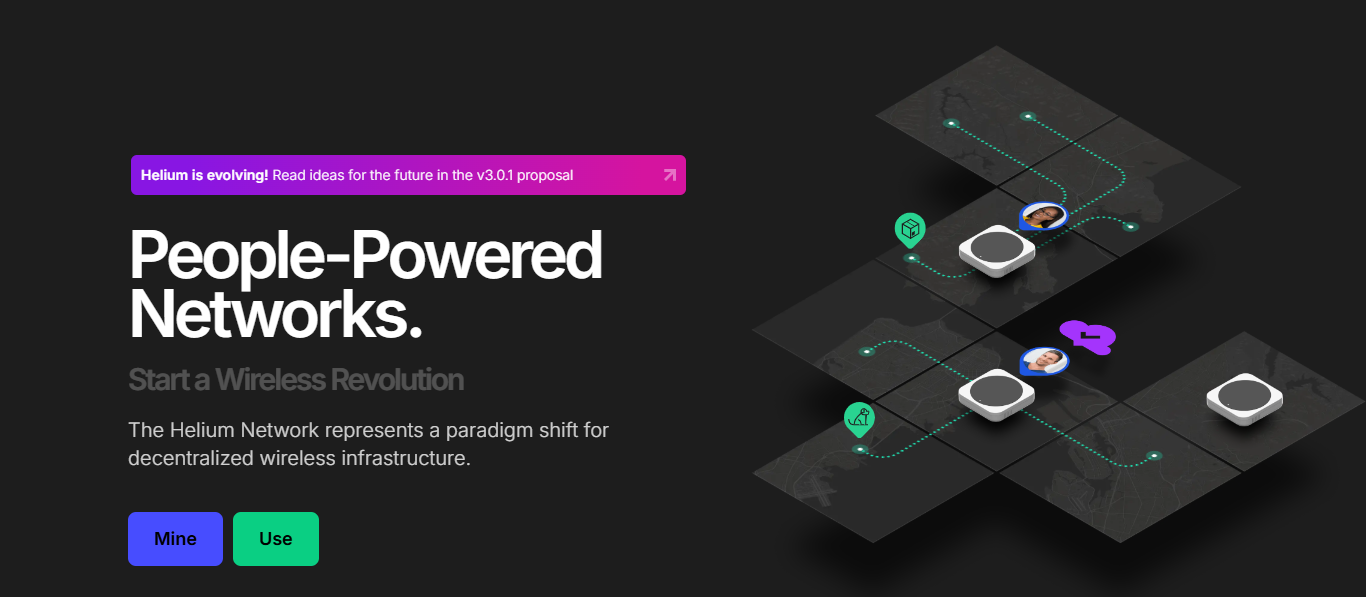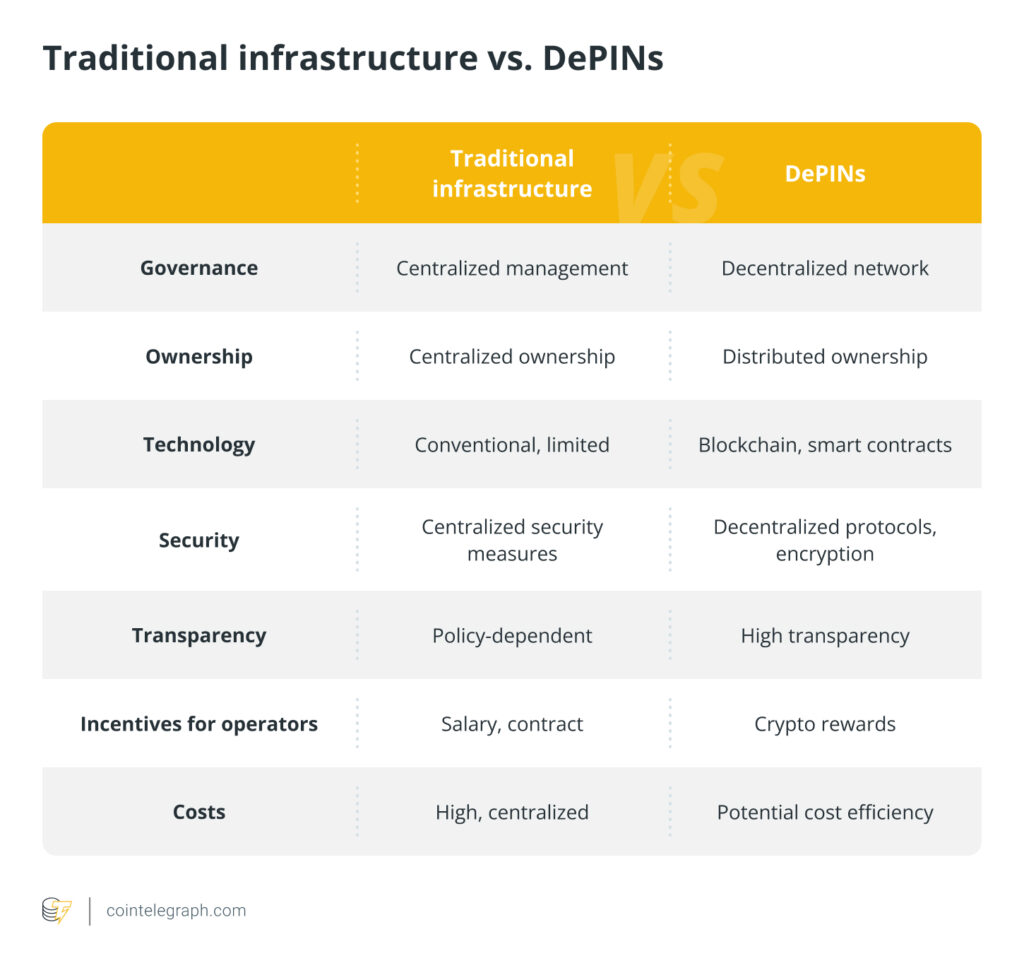







































Can “DePINs” Fix the Telecom Industry’s Woes?
 MOBILE
MOBILE
 NADA
NADA
 2024
2024
 2024
2024
 HNT
HNT
Decentralized Physical Infrastructures, “DePINs,” has been touted as a promising solution to many of the challenges facing the telecom industry today. The sector recorded over 30,458 security incidents in 2023, including a 180% increase in zero-day attacks. With billions of devices needing secure, reliable connections, the traditional, centralized telecom model is straining under high infrastructure costs, security vulnerabilities, and an inability to reach remote areas effectively.
By leveraging blockchain technology, DePINs decentralizes the ownership and management of physical infrastructure, enabling a more efficient and cost-effective model for telecom services. Companies like Uplink and Helium Mobile are at the forefront of building these new systems. We have also seen large companies such as Lufthansa and Deutsche Telekom partnering to implement them. These partnerships highlight how big some companies are betting on DePIN solutions to enhance their operations.
How DePIN Can Fix Telecom Challenges
One of the biggest struggles for telecom companies is the massive expense required to deploy and maintain the infrastructure, such as antennas and fibre networks, needed to keep services running. In addition to this, they also face difficulties in expanding their networks, especially in underserved or remote regions, due to the high costs of leasing land and installing equipment.
With DePIN systems, users—individuals and communities—participate in building the infrastructure that provides network coverage. This means anyone with the wherewithal can set up the necessary infrastructure for the network and get it connected on a “gird.” In places and communities with no or poor network reception, those interested set up the necessary infrastructure. This decentralized approach allows for much faster and more efficient scaling than conventional telecom systems, bringing coverage to places that traditional models have long ignored.

Projects like Helium Mobile, for instance, allow individuals to set up wireless hotspots that build a network providing low-power internet access for Internet of Things (IoT) devices. In return for contributing to this network, participants earn HNT, Helium’s native cryptocurrency. This infrastructure can help telecom operators offload traffic without the need for significant capital investments or ongoing maintenance costs.

Also, DePIN’s decentralized system translates into lower service costs for consumers and businesses alike. Without large-scale investments in infrastructure, providers can offer services at a fraction of the price. Amir Haleem, CEO of Helium Mobile and Nova Labs, claimed that Helium Mobile aims to redefine the wireless telecommunications industry by creating a decentralized network built and owned by the community and thus make affordable, unlimited mobile services possible.

Reliability is another area where DePIN shines. Telecom networks are often vulnerable to outages and need regular maintenance, as seen in February 2024, when an AT&T outage affected millions of users in the U.S., and again in March, when a major telecom failure across West Africa disrupted services due to undersea cable damage.
DePINs create a more resilient system by distributing the infrastructure across many participants. This decentralized model is less vulnerable to widespread failures and can scale quickly, as anyone can set up new infrastructure without the need for large investments.
Are DePINs Feasible & Viable Solutions?
The addressable market for DePIN technology is substantial, valued at $2.2 trillion in 2024 and expected to reach $3.5 trillion by 2028. However, the feasibility of DePIN as a full replacement for traditional telecom infrastructure is debatable.
As Haleem pointed out, integrating DePIN requires a telecom-wide overhaul, which could be a significant hurdle for an industry accustomed to centralized models. Many existing telecom operators have operated on static infrastructure for years, making the shift to a decentralized, user-participation model both technically and culturally challenging.
The telecom industry is built on tightly controlled, centralized systems with high expectations for quality and consistency. A decentralized model could introduce variability in service quality and network coverage, as it’s harder to ensure uniform standards when infrastructure is dispersed and individually managed. Not all DePIN infrastructure operates equally well, and this will definitely lead to inconsistencies in reliability, speed, and user experience.
Also, DePIN’s decentralized incentives can inadvertently widen digital divides. Areas with limited connectivity or fewer willing participants may struggle to attract necessary infrastructure deployments, potentially deepening inequalities in access to reliable, affordable internet services. Addressing this issue will require not only incentives for deployment but also support for consistent service quality in underserved areas or risk undermining the equitable access that DePIN advocates aim to provide.
Security is another concern. With more entry points in a decentralized model, DePIN systems could face increased exposure to cyberattacks. Telecom has been especially vulnerable, as shown by a surge in ransomware attacks targeting unpatched devices in 2023. DePIN’s decentralized nature makes it harder to enforce uniform security protocols, potentially leaving certain segments of the network more exposed than others.
Regulation also complicates DePIN’s deployment. Compliance with data privacy, security standards, and operational transparency is essential yet challenging for decentralized projects. Many jurisdictions have strict telecom regulations that decentralized networks may struggle to meet, creating uncertainty that could deter investment.
In summary, DePINs offer a new pathway for telecom by decentralizing infrastructure deployment and maintenance. While these systems can reduce costs, improve coverage in remote areas, and enhance resilience, significant hurdles—security, regulatory compliance, and consistent quality—must be addressed. DePINs could complement, rather than replace, traditional telecom models, potentially transforming the industry if deployed with careful consideration of these challenges.
Disclaimer: This article is intended solely for informational purposes and should not be considered trading or investment advice. Nothing herein should be construed as financial, legal, or tax advice. Trading or investing in cryptocurrencies carries a considerable risk of financial loss. Always conduct due diligence.
If you would like to read more market analyses like this, visit DeFi Planet and follow us on Twitter, LinkedIn, Facebook, Instagram, and CoinMarketCap Community.
Take control of your crypto portfolio with MARKETS PRO, DeFi Planet’s suite of analytics tools.
The post Can “DePINs” Fix the Telecom Industry’s Woes? appeared first on DeFi Planet.

